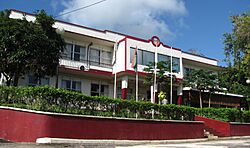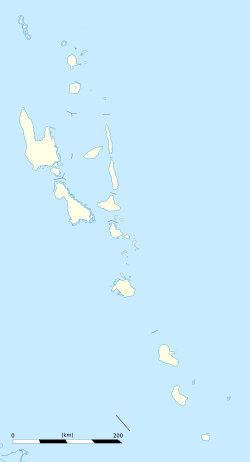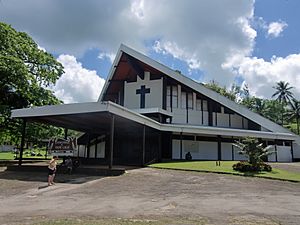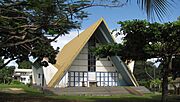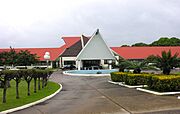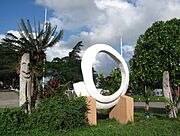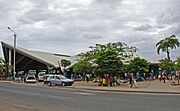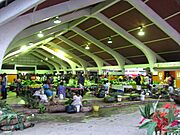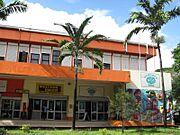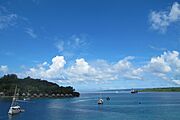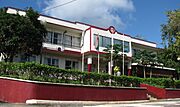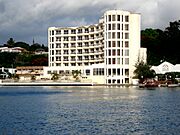Port Vila facts for kids
Quick facts for kids
Port Vila
Vila
|
||
|---|---|---|
|
City
|
||
|
From top: left to right – aerial view of central Port Vila, Parliament building, Port Vila Harbour and Port Vila City Hall.
|
||
|
||
| Country | ||
| Province | Shefa Province | |
| Island | Efate | |
| Area | ||
| • Total | 23.6 km2 (9.1 sq mi) | |
| Elevation | 59 m (194 ft) | |
| Population | ||
| • Total | 49,034 | |
| • Density | 2,078/km2 (5,381/sq mi) | |
| Time zone | UTC+11 (VUT) | |
Port Vila ( French: Port-Vila), often called Vila, is the capital and largest city of Vanuatu. It is located on the island of Efate.
In 2020, about 49,034 people lived in Port Vila. This means that 16.3% of Vanuatu's total population lived in the city.
Port Vila is on the south coast of Efate island, in Shefa Province. It is the main place for business and trade in Vanuatu. The current mayor is Jenny Regenvanu. She is from the Land and Justice Party and was elected in August 2024. She is the first woman to be mayor of Port Vila. Her deputy is Marie Louise Milne.
Contents
What's in a Name?
Locally, people usually just call the city "Vila." This is true whether they speak French, Bislama, or English. It is pronounced like "VEE-lə."
The original name for this area is Efil in the local South Efate language. It is called Ifira in the nearby Mele-Fila language. The name Vila comes from these older names. There is also a small island called Ifira in Vila harbour. Many of the original landowners live there.
A Look Back: History of Port Vila
People from Melanesia have lived in the Port Vila area for thousands of years. In 2004, archaeologists found a burial site. It had 25 tombs with 36 skeletons from the Lapita culture. Pottery found there was from the 13th century BC.
James Cook mapped Efate Island in 1774. He named it Sandwich Island. His team did not land, but they saw good harbours. They also noted land that would be good for European settlers. In the late 1800s, the islands were known as the New Hebrides. The British were the first main European group.
By the 1890s, the French started to have more economic power. They set up large farms. A French citizen, Ferdinand Chevillard, bought land around Port Vila. He planned to make it the biggest French farm. Instead, it became the town of Franceville. This town declared itself independent on August 9, 1889. However, this independence only lasted until June of the next year.
Franceville was the first self-governing place to allow everyone to vote. This included people of all genders and races. But only white people could hold office. One of the elected presidents was R. D. Polk, who was related to US President James K. Polk.
After 1887, both the French and the British ruled the area together. This was made official in 1906. It was called an Anglo-French Condominium. During World War II, Port Vila was an important airbase for American and Australian forces.
The city has faced natural disasters. In 1987, Cyclone Uma caused a lot of damage. A strong earthquake in January 2002 also caused some damage. On March 13, 2015, Cyclone Pam, a very powerful storm, hit the city hard. In December 2024, a 7.3 magnitude earthquake damaged almost every house. It sadly caused 19 deaths. The United Nations said that 116,000 people were affected. This is about one-third of Vanuatu's population.
Port Vila's Location and Weather
What is the Climate Like?
Port Vila has a tropical climate. This means it is warm all year round. It has both wet and dry seasons. Strong winds called trade winds blow almost all the time. Cyclones (tropical storms) can also happen.
The city gets about 2,338.9 millimetres or 92.08 inches of rain each year. March is usually the wettest month. September is the driest. On average, it rains 153 days a year. Temperatures do not change much. The highest temperature ever recorded was 35.6 °C or 96.1 °F.
In July, the coolest month, the average high is 27 °C or 80.6 °F. The average low is 18 °C or 64.4 °F. February is the hottest month. It has an average high of 31.2 °C or 88.2 °F and an average low of 23 °C or 73.4 °F. The lowest temperature ever recorded was 8.5 °C or 47.3 °F. The air is often very humid.
| Climate data for Port Vila, Vanuatu (Bauerfield International Airport) | |||||||||||||
|---|---|---|---|---|---|---|---|---|---|---|---|---|---|
| Month | Jan | Feb | Mar | Apr | May | Jun | Jul | Aug | Sep | Oct | Nov | Dec | Year |
| Record high °C (°F) | 35.0 (95.0) |
33.9 (93.0) |
33.5 (92.3) |
32.5 (90.5) |
31.1 (88.0) |
32.0 (89.6) |
34.3 (93.7) |
32.0 (89.6) |
31.5 (88.7) |
31.2 (88.2) |
33.0 (91.4) |
35.6 (96.1) |
35.6 (96.1) |
| Mean daily maximum °C (°F) | 31.3 (88.3) |
31.2 (88.2) |
30.8 (87.4) |
29.9 (85.8) |
28.8 (83.8) |
27.4 (81.3) |
26.4 (79.5) |
27.0 (80.6) |
27.7 (81.9) |
28.5 (83.3) |
29.2 (84.6) |
30.7 (87.3) |
29.1 (84.4) |
| Daily mean °C (°F) | 26.4 (79.5) |
26.5 (79.7) |
26.3 (79.3) |
25.3 (77.5) |
24.1 (75.4) |
23.0 (73.4) |
22.1 (71.8) |
22.0 (71.6) |
22.7 (72.9) |
23.4 (74.1) |
24.6 (76.3) |
25.7 (78.3) |
24.3 (75.7) |
| Mean daily minimum °C (°F) | 22.5 (72.5) |
23.0 (73.4) |
22.6 (72.7) |
22.0 (71.6) |
20.2 (68.4) |
19.8 (67.6) |
18.2 (64.8) |
18.0 (64.4) |
18.4 (65.1) |
19.6 (67.3) |
20.7 (69.3) |
21.7 (71.1) |
20.5 (68.9) |
| Record low °C (°F) | 15.8 (60.4) |
15.0 (59.0) |
16.3 (61.3) |
14.5 (58.1) |
13.4 (56.1) |
10.0 (50.0) |
8.5 (47.3) |
10.0 (50.0) |
9.9 (49.8) |
11.0 (51.8) |
12.6 (54.7) |
15.2 (59.4) |
8.5 (47.3) |
| Average rainfall mm (inches) | 316.1 (12.44) |
273.7 (10.78) |
320.9 (12.63) |
255.2 (10.05) |
210.3 (8.28) |
180.0 (7.09) |
94.4 (3.72) |
87.4 (3.44) |
87.3 (3.44) |
134.1 (5.28) |
192.3 (7.57) |
187.2 (7.37) |
2,338.9 (92.09) |
| Average rainy days (≥ 1.0 mm) | 15.4 | 16.6 | 18.5 | 17.1 | 12.9 | 11.3 | 10.3 | 9.8 | 8.1 | 8.4 | 12.1 | 13.2 | 153.7 |
| Average relative humidity (%) | 84 | 85 | 86 | 87 | 85 | 85 | 83 | 82 | 80 | 81 | 82 | 83 | 84 |
| Average dew point °C (°F) | 24 (75) |
24 (75) |
24 (75) |
23 (73) |
21 (70) |
21 (70) |
20 (68) |
20 (68) |
20 (68) |
21 (70) |
22 (72) |
23 (73) |
22 (71) |
| Mean monthly sunshine hours | 220.1 | 155.4 | 198.4 | 165.0 | 170.5 | 162.0 | 148.8 | 167.4 | 174.0 | 198.4 | 180.0 | 195.3 | 2,135.3 |
| Mean daily sunshine hours | 7.1 | 5.5 | 6.4 | 5.5 | 5.5 | 5.4 | 4.8 | 5.4 | 5.8 | 6.4 | 6.0 | 6.3 | 5.8 |
| Source 1: Deutscher Wetterdienst | |||||||||||||
| Source 2: Time and Date (dewpoints, between 2005–2015) | |||||||||||||
How Does Port Vila Make Money?
Port Vila is Vanuatu's most important harbour. It is the main place for trade in the country. The international airport, Bauerfield International (VLI), is also in the city. Air Vanuatu has its main office here.
Farming and fishing are big industries in Port Vila. Tourism is also growing, especially with visitors from Australia and New Zealand. In 1997, over 80,000 tourists visited.
Vanuatu is known as a tax haven. This means it has low taxes for foreign businesses. Offshore financing in Port Vila is an important part of its economy.
Vanuatu still gets help from other countries. Most of this help comes from Australia and New Zealand. Recently, China has also provided assistance. For example, New Zealand helped train doctors. Australia has sent experts to work in Port Vila Central Hospital.
About 35.7% of Vanuatu's exports leave from Port Vila. Also, 86.9% of all imports arrive in Port Vila.
Who Lives in Port Vila?
People and Languages
The population is around 45,000 people. Most residents are Melanesian. There are also smaller groups of Polynesian, Asian, Australian, and European people. Many Europeans are French or British.
Port Vila is home to many languages. This shows how many different languages are spoken in Vanuatu.
The main language used every day in the capital is Bislama. But English and French are also widely spoken.
Vanuatu has about 100 local languages. Many of these are spoken in Port Vila. This is because people from rural areas move to the city.
What Religions are Practiced?
Christianity is the main religion in Vanuatu. Over 90% of the people follow it. The largest Christian group is the Presbyterian Church in Vanuatu. About one-third of the population belongs to this church. Roman Catholicism and the Church of Melanesia are also common. Each makes up about 15% of the population.
Cathédrale du Sacré-Cœur is a modern Roman Catholic church in Port Vila. It is dedicated to the Sacred Heart of Jesus. In October 2020, The Church of Jesus Christ of Latter-day Saints announced plans to build a temple in the city. The Baháʼí Faith community also has a presence in Port Vila.
Culture and Learning
What to See in the City
Port Vila has many interesting places to visit. You can find several memorials. For example, across from the Parliament, there are two traditional totem poles. There is also a monument shaped like a pig's tusk. The Presbyterian Church of Port Vila is a beautiful building. It is across from Independence Park.
You can see a colorful wall painting on the administration building. It is opposite the market hall. Another notable painting is on the post office building. The City Hall of Port Vila is a long, impressive building. It sits on a hill in the city center.
- Cityscape
Vanuatu Cultural Centre
The Vanuatu Cultural Centre is a very important place. It is home to the National Museum of Vanuatu. It is located at Saralana Park, near the National Parliament. The National Library and the Malvatumauri (Vanuatu National Council of Chiefs) are also nearby. This center works to protect and share the local culture.
The museum displays traditional items from many islands. The center also has the National Audiovisual Archives. This is a huge collection of documents from the late 1800s until today.
World Heritage Efforts
In August 1999, Port Vila hosted a meeting for UNESCO. This meeting focused on World Heritage in the Pacific Islands. A key topic was whether underwater historical sites could be added to the World Heritage List.
Schools and Education
Port Vila is one campus of the University of the South Pacific. This university is shared by twelve Pacific countries. The Vanuatu campus is the only place in the university that teaches law. It also teaches languages.
Here are some of the high schools in Port Vila:
- Port Vila International School
- Central Secondary School
- Epauto Adventist Senior Secondary School
- Lycee de Montmartre
- Lycée Français J. M. G. Le Clézio (a French international school)
- Malapoa College (formerly British Secondary School)
- Onesua Presbyterian College
- NTCU Port Vila Christian College
Some of the junior high schools include:
- Port Vila International School
- Central Secondary School
- Malapoa College (formerly British Secondary School)
- NTCU Port Vila Christian College
- Seaside Community Secondary School
- Sorovanga Self-Support Community School
- Suango Mele Junior Secondary School
- Ulei Junior Secondary School
- Vila North Secondary School
How Port Vila is Governed
The City Council
The city of Port Vila is divided into four main areas called wards. A council of 14 members manages the city. The four wards are:
- Malapoa-Tagabe: This covers the western and far northern parts of the city.
- Anabrou-Melcofe-Tassiriki: This includes the northern and eastern areas.
- Centre: This ward has the Nambawan and Seaside neighborhoods.
- South: This covers Nambatu, Nambatri, and Elluk neighborhoods.
Malapoa-Tagabe and South each have three representatives on the council. Anabrou-Melcofe-Tassiriki and Centre each have four.
The city council is in charge of many things. These include primary education and health care. They also handle city planning, road maintenance, and trash collection. They manage cemeteries, parks, and promote tourism.
Some areas, like Blacksands, are like suburbs of Vila but are not officially part of the city. Living conditions in some of these areas can be difficult. People there often lack basic services and secure land rights. Blacksands was first settled without official permission in the 1960s.
The most recent city council election was held in 2022.
Members of Parliament
Port Vila is one of Vanuatu's 18 constituencies. It elects six Members of Parliament. After the 2016 general election, its representatives were:
| Member | Party |
|---|---|
| Kenneth Natapei | Vanua'aku Pati |
| Alatoi Ishmael Kalsakau | Union of Moderate Parties |
| Jean Pierre Nirua | Independent |
| Kalo Seule | Green Confederation |
| Ephraim Kalsakau | Independent |
| Ulrich Sumptoh | Union of Moderate Parties |
Sister Cities
Port Vila has "sister city" relationships with other cities around the world. This means they share cultural and educational ties.
See also
 In Spanish: Port Vila para niños
In Spanish: Port Vila para niños





